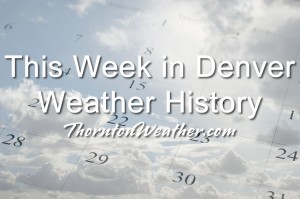
Spring snowstorms can pack more of a wallop than those in other seasons due to the heavy, wet snow they bring. Our look back at this week in Denver weather history shows numerous snow events that have had significant impacts on northeastern Colorado.
From the National Weather Service:
3-6
In 1898…snowfall totaled 8.7 inches in downtown Denver over the 4 days. Northeast winds were sustained to 48 mph with gusts as high as 60 mph on the 3rd.
In 1983…a prolonged heavy snow storm blanketed the area along with very cold temperatures. The greatest amounts of snow fell in the foothills where 24 to 42 inches were measured. A foot of snow fell in Boulder. Snow fell for 50 consecutive hours at Stapleton International Airport on the 3rd through the 5th with a total snowfall of 8.8 inches and a maximum accumulation on the ground of 6 inches on the 5th. In Denver…the mercury failed to rise above freezing for 3 consecutive days…on the 4th…5th…and 6th…for the first time ever in April. Five daily temperature records were set from the 4th through the 6th. Record low temperatures of 12 degrees occurred on the 5th with 7 degrees on the 6th. Record low maximum temperatures of 25 degrees occurred on the 4th…27 degrees on the 5th… And 28 degrees on the 6th.
4-7
In 1909…post-frontal rain changed to heavy snow on the afternoon of the 4th and continued through mid-morning of the 7th. Total snowfall was 18.7 inches…but most of the snow…14.0 inches…fell from 6:00 pm on the 4th to 6:00 pm on the 5th. North to northeast winds were sustained to 32 mph on the 4th and to 30 mph on the 7th. Total precipitation from the storm was 1.78 inches.
5-6
In 1939…3.0 inches of snow fell in downtown Denver. North winds were sustained to 34 mph on the 5th and to 26 mph on the 6th. The strong winds caused considerable drifting of snow. Several highways leading into the city were closed during the height of the storm due to poor visibility. Streets and highways became coated with ice in places. The temperature dipped to 11 degrees early on the 6th. This was the coldest reading of the month that year. Most vegetation was not far enough advanced to be injured by the cold temperatures…although a few buds froze on early shrubbery.
In 1949…strong winds in Boulder caused limited minor damage. West-northwest winds were sustained to 24 mph with some higher gusts at Stapleton Airport.
5-7
In 1916…rain changed to snow behind a cold front on the 5th and totaled 4.5 inches in the city. A thunderstorm produced snow on the 6th. North winds were sustained to 35 mph with gusts to 38 mph on the 7th.
6
In 1904…northwest winds were sustained to 40 mph with gusts to 48 mph.
In 1919…post-frontal rain changed to snow but totaled only 0.1 inch. However…north winds were sustained to 40 mph with gusts to 44 mph in the city.
In 1954…a vigorous cold front produced northeast winds at 38 mph with gusts as high as 50 mph. The strong winds briefly reduced visibility to 1 1/2 miles in blowing dust at Stapleton Airport.
In 1972…wind gusts to 68 mph were recorded at the National Bureau of Standards in Boulder. Winds peaked to 54 mph in downtown Boulder. Minor damage was reported. Northwest winds gusted to 44 mph at Stapleton International Airport where the strong Chinook winds warmed the temperature to a high of 80 degrees…equaling the record maximum for the date.
6-7
In 1872…rain changed to snow overnight. Snow with high north winds continued all day on the 7th. Precipitation (rain and melted snow) totaled 0.50 inch. Due to problems on the lines…the morning weather report was not sent by telegraph until 3:10 pm and the midnight report was not sent at all.
In 1957…heavy snowfall totaled 6.6 inches at Stapleton Airport where north winds gusted to 46 mph. This was the second heavy snow event in less than 4 days.
In 1969…winds gusting as high as 50 to 60 mph caused only light damage along the eastern foothills. The strong winds contributed to the spread of a forest fire near Boulder. Sustained winds of 25 mph with gusts to 53 mph were recorded in Boulder. Southwest winds gusted to 38 mph on the 6th and 44 mph on the 7th at Stapleton International Airport.
In 1980…high winds howled along the foothills each day. A wind gust to 72 mph was recorded in Lakewood. The strong winds blew a camper top off a pickup truck in Denver. At Stapleton International Airport…west winds gusted to 41 mph on both days.
In 1998…a spring storm brought a mix of snow and thunder to metro Denver…the foothills…and Palmer Divide. Conifer and Elizabeth both measured 4 inches of new snow. On the 6th…only 0.1 inch of snow fell at the site of the former Stapleton International Airport where thunder was heard on both days. Precipitation totaled 0.60 inch at Denver International Airport where west winds gusted to 43 mph on the 6th.
6-8
In 1973…a major spring snow storm dumped 11.6 inches of snowfall over metro Denver. North wind gusts of 30 to 35 mph produced some blowing snow. Most of the heavy wet snow… 10.1 inches…fell on the 7th when temperatures remained in the 20’s. Snow accumulated on the ground to a maximum depth of 9 inches. Low temperature of 5 degrees on the 8th was a new record minimum for the date and the lowest for so late in the season.
Continue reading April 6 to April 12: This Week in Denver Weather History
